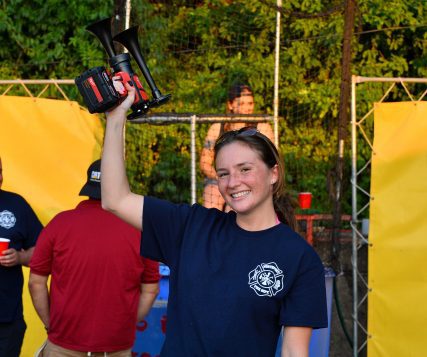Residents of the Northport-East Northport school district have waited anxiously for the recent report by the New York State Department
of Health.
According to a NYSDOH study, the investigation of cancer incidents in the school district between 1999 and 2018 was initiated by the department “in response to an inquiry from members of the community who shared information about leukemias and other cancers diagnosed among members of the Northport High School graduating class of 2016 since their graduation and among other children and young adults in the Northport area.” The report also mentioned health concerns cited about Northport Middle School students.
In January 2020, the district decided to close the middle school for a few months after the consulting firm hired by the district, P.W. Grosser Consulting, tested the soil on the grounds and found elevated levels of benzene in two separate septic systems on site. Before a cleanup, three science classrooms in the middle school’s G-wing were closed out of an abundance of caution. During the investigation, it was found science rooms had sinks that drain into the leaching pool, where the mercury and silver were found. While odorless fumes could have potentially migrated through the piping into classrooms, the drain systems rely on P traps that prevent that from occurring, according to the district at the time. Air quality results in the G-wing classrooms were later found to be normal.
The DOH’s primary source of data was the New York State Cancer Registry. For the years after 2018, registry data was not official at the time of analyses, according to the DOH report.
“We identified 4,593 cases of cancer among district residents, compared with 4,454 that would be expected,” the report read. “This 3% excess was statistically significant, meaning it was unlikely to occur by chance.”
An increase in pancreatic cancer, malignant melanoma of the skin, uterine (corpus) cancer and prostate cancer made up the excess. The report went on to say, “There were significantly fewer than expected numbers of cases of stomach cancer and lung cancer. Numbers of cases of leukemia, other blood cancers (Hodgkin and non-Hodgkin lymphomas and multiple myeloma), and 13 other types of cancer examined separately were not significantly different from expected.”
While the community around East Northport Middle School had about the expected cases, the area around Northport Middle School had 7% higher-than-expected levels of cancer.
Regarding the number of 2016 high school graduates who came down with leukemia, the study concluded, “It is possible that the elevated occurrence of leukemia among 2016 graduates could be related to factors not possible to uncover, including environmental exposures.”
Robert Banzer, district superintendent of schools, sent out a letter June 23 to community members to notify them that the study was completed. In the letter, he said, “The district fully cooperated with the NYSDOH during this process.”
After summarizing the findings in the letter, he said, “We appreciate the hard work of the NYSDOH in this endeavor and look forward to continuing to provide our students and staff with a safe learning environment.”
Lawsuits and disappointment in health study
Attorney Lilia Factor, of Melville-based Napoli Shkolnik PLLC, said her law firm has filed three lawsuits for nine plaintiffs so far against the Northport-East Northport school district. One of them is a proposed class-action lawsuit on behalf of all Northport Middle School students. The others are on behalf of individuals who have become sick. She is aware of at least five other lawsuits in total as other law firms have filed lawsuits against the district in the Suffolk County Supreme Court.
On July 12, according to Factor, the court consolidated lawsuits for the purposes of exchanging documents and depositions. A most recently filed case from Napoli Shkolnik was not included as a judge has not been assigned yet.
Tara Mackey is one of the plaintiffs in the class-action lawsuit. She said her daughter suffered from migraine headaches while studying at Northport Middle School and developed asthma. When Mackey brought her daughter to the doctor for her headaches, carbon monoxide was found in her blood.
“She had to get blood tests every four to six weeks for the remainder of time that she was in the school, and it just showed a pattern of when they would test her blood after, say, five days a week of school, she would have very high levels of carbon monoxide in her blood and then when they tested it during holidays or summer break, it was perfectly normal,” Mackey said.
Factor said while Mackey’s daughter was fortunate not to get cancer, she and other students are at a higher risk of developing illness later in life due to latency periods, a fact she said the NYSDOH report acknowledges. If the class-action suit is successful, anyone who becomes sick in later years would be covered. In cases such as this, a fund is established where people can be tested or a protocol would be distributed to local doctors to know what to look for if a patient attended Northport Middle School
“We want there to be a medical monitoring program established for everyone so that they can screen people and watch them, and if they develop any symptoms of a serious illness that’s associated with these contaminants to try to catch it early,” Factor said.
Mackey said the health issues can weigh heavily on families, and many of them faced criticism in Northport when they brought the problems to the district. She and her family moved to South Carolina after they were harassed by community members creating uncomfortable situations.
“We endured a lot of harassment, along with a lot of other parents, from people in the community that didn’t want bad press about any potential environmental issues that could lead to health problems for people in the school and the community, because people feared for their property values,” she said. “It just made a very uncomfortable situation for many of us, and we moved because we couldn’t keep our kids safe.”
She added, coincidentally, two other families, who she didn’t know while living in Northport, moved near her.
Factor said while it is good that the DOH conducted the report, the study didn’t look at other factors such as families who have moved away and may have been diagnosed with an illness.
“They would not be part of those statistics, which were in themselves pretty disturbing,” Factor said.
She added the DOH didn’t talk to or survey community members and medical providers.
“It’s good that they did something, but it really needs to be a lot more comprehensive if they really want to understand cancer incidence in this community.” Factor said.
The attorney and Mackey added there have been other illnesses that have surfaced such as scleroderma and aplastic anemia. Mackey said that she was also disappointed that the study was cut off at the year 2018 as she has heard of more cases of cancer that have been diagnosed recently and therefore not counted.
“I just think all of the families and the parents, children themselves, they at least deserve the facts and the full facts,” the mother said. “Nothing can change at this point. We can’t change what happened to our children, but at least we can take charge and be observant and try to keep them in the best health possible and at least know what to look for.”


































